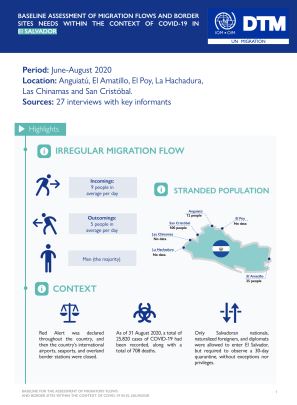-
Countries
-
Data and Analysis
-
Special Focus
-
Crisis Responses
El Salvador-Baseline assesment of migration flows and border sites needs within the context of COVID-19, #1 (June-August 2020)

Contact
Cecilia Ramirez cramirez@iom.int
Language
English
Location
El Salvador
Period Covered
Jun 01 2020
Aug 31 2020
Activity
- Baseline Assessment
- Event Tracking
Due to the alarming levels of propagation and the serious nature of the COVID-19 virus, on 11 March 2020 the OMS declared a State of Pandemic. On 14 March, the Government of El Salvador decreed a national quarantine through the enactment of the Act for Temporary Restriction of Specific Constitutional Rights due to the COVID-19 Pandemic. In addition, a State of National Emergency, Public Calamity, and Natural Disaster was declared for the entire country due to the Pandemic.
The first case of COVID-19 in El Salvador was confirmed on 18 March 2020, with the first death recorded in the country on 01 April. El Salvador has established various guidelines for preventing COVID-19 contagions. Red Alert was declared throughout the country and then the country’s international airports, seaports, and overland border stations were closed, with the resulting interruption of international flights.
Salvadoran nationals, naturalized foreigners, and diplomats who entered El Salvador were required to observe a 30-day quarantine, without exceptions nor privileges. In addition, any Salvadoran national or foreigner caught attempting to enter the country through an uncontrolled border crossing point would face charges brought by the Public Ministry.
In light of the situation caused by the COVID-19 Pandemic, the IOM seeks to determine: the impact of same on mobility in regular and irregular migratory flows; the needs of migrants; and the measures taken to prevent propagation of the virus along the borders of El Salvador. This is the reason this Study was carried out, in order to generate baselines for comprehending existing needs at the official and unofficial points of entry, in order to provide input to orient actions to be taken by protection organizations at the inter-agency level, local governments, cross-border panels, and IOM field personnel.
